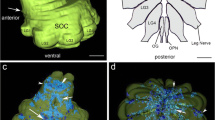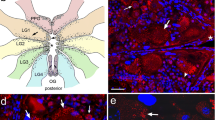Abstract
Similar to hair cells in the mammalian cochlear system, mechanosensory neurons in the Central American wandering spider Cupiennius salei are strongly innervated by efferent fibers that originate from neurons whose somata are located in the central nervous system (CNS). In both the mammalian and arachnid systems, efferent fibers have been shown to co-express two or more transmitters; however, our understanding regarding co-transmission and how it affects sensory signal transduction and processing in these systems is only fragmentary. The spider model system is exceptionally suitable for this type of investigation due to the large size and easy accessibility of the sensory and efferent neurons in this system. Thus far, GABA and glutamate have been identified as the main fast-acting transmitters in efferent axons that form synaptic contacts onto sensory neurons in slit sense organs. Ultrastructural investigations suggest an abundance of neuropeptides within these peripheral synapses. In an effort to identify these peptides and conduct functional studies, we have employed immunohistochemistry to investigate whether the neuropeptide proctolin is present in neurons of the leg ganglia and in peripheral leg structures. Here, we demonstrate that ~ 73% of all neurons in the CNS of C. salei show proctolin-like immunoreactivity (proc-LIR) including the leg ganglia. We demonstrate that both strongly and weakly labeled neurons can be distinguished. The majority of proc-LIR neurons show weak labeling intensity and ~ 86.2% co-localize with glutamate. In future experiments, we plan to undertake functional studies to investigate the significance of this co-expression, which has yet to be investigated.






Similar content being viewed by others
References
Babu KS, Barth FG (1984) Neuroanatomy of the central nervous system of the wandering spider, Cupiennius salei (Arachnida, Araneida). Zoomorphology 104:344–359
Bartos M, Allgäuer C, Eckert M, Honegger H (1994) The antennal motor system of crickets: proctolin in slow and fast motoneurons as revealed by double labelling. Eur J Neurosci 6:825–836
Becherer C, Schmid A (1999) Distribution of γ-aminobutyric acid-, proctolin-, Periplaneta hypertrehalosaemic hormone- and FMRFamide-like immunoreactivity in the visual ganglia of the spider Cupiennius salei Keys. Comp Biochem Physiol A Mol Integr Physiol 122:267–275
Brown B (1967) Neuromuscular transmitter substance in insect visceral muscle. Science 155:595–597
Egerod K, Reynisson E, Hauser F, Williamson M, Cazzamali G, Grimmelikhuijzen CJ (2003) Molecular identification of the first insect proctolin receptor. Biochem Biophys Res Commun 306:437–442
Elekes K, Florey E (1987a) Immunocytochemical evidence for the GABAergic innervation of the stretch receptor neurons in crayfish. Neuroscience 22:1111–1122
Elekes K, Florey E (1987b) New types of synaptic connections in crayfish stretch receptor organs: an electron microscopic study. J Neurocytol 16:613–626
Erxleben C, DeSantis A, Rathmayer W (1995) Effects of proctolin on contractions, membrane resistance, and non-voltage-dependent sarcolemmal ion channels in crustacean muscle fibers. J Neurosci 15:4356–4369
Fabian-Fine R, Anderson CM, Roush MA, Johnson JAG, Liu H, French AS, Torkkeli PH (2017) The distribution of cholinergic neurons and their co-localization with FMRFamide, in central and peripheral neurons of the spider Cupiennius salei. Cell Tissue Res 370:71–88
Fabian-Fine R, Meinertzhagen IA, Seyfarth EA (2000) Organization of efferent peripheral synapses at mechanosensory neurons in spiders. J Comp Neurol 420:195–210
Fabian-Fine R, Meisner S, Torkkeli PH, Meinertzhagen IA (2015) Co-localization of gamma-aminobutyric acid and glutamate in neurons of the spider central nervous system. Cell Tissue Res 362:461–479
Fabian-Fine R, Volknandt W, Seyfarth E (1999) Peripheral synapses at identifiable mechanosensory neurons in the spider Cupiennius salei: synapsin-like immunoreactivity. Cell Tissue Res 295:13–19
Fabian R, Seyfarth EA (1997) Acetylcholine and histamine are transmitter candidates in identifiable mechanosensitive neurons of the spider Cupiennius salei: an immunocytochemical study. Cell Tissue Res 287:413–423
Gaffin D, Brownell P (1997) Electrophysiological evidence of synaptic interactions within chemosensory sensilla of scorpion pectines. J Comp Physiol A 181:301–307
Hooper SL, Marder E (1984) Modulation of a central pattern generator by two neuropeptides, proctolin and FMRFamide. Brain Res 305:186–191
Li X, Bucher D, Nadim F (2018) Distinct co-modulation rules of synapses and voltage-gated currents coordinate interactions of multiple neuromodulators. J Neurosci 38:8549–8562
Loesel R, Seyfarth E-A, Bräunig P, Agricola H-J (2011) Neuroarchitecture of the arcuate body in the brain of the spider Cupiennius salei (Araneae, Chelicerata) revealed by allatostatin-, proctolin-, and CCAP-immunocytochemistry and its evolutionary implications. Arthropod Struct Dev 40:210–220
Mercier A, Lee J (2002) Differential effects of neuropeptides on circular and longitudinal muscles of the crayfish hindgut. Peptides 23:1751–1757
Orchard I, Lee DH, Da Silva R, Lange AB (2011) The proctolin gene and biological effects of proctolin in the blood-feeding bug, Rhodnius prolixus. Front Endocrinol 2:59
Panek I, Torkkeli PH (2005) Inhibitory glutamate receptors in spider peripheral mechanosensory neurons. Eur J Neurosci 22:636–646
Pfeiffer K, Panek I, Hoger U, French AS, Torkkeli PH (2009) Random stimulation of spider mechanosensory neurons reveals long-lasting excitation by GABA and muscimol. J Neurophysiol 101:54–66
Rabbitt RD, Brownell WE (2011) Efferent modulation of hair cell function. Curr Opin Otolaryngol Head Neck Surg 19:376–381
Salio C, Lossi L, Ferrini F, Merighi A (2006) Neuropeptides as synaptic transmitters. Cell Tissue Res 326:583–598
Schrott-Fischer A, Kammen-Jolly K, Scholtz A, Rask-Andersen H, Glueckert R, Eybalin M (2007) Efferent neurotransmitters in the human cochlea and vestibule. Acta Otolaryngol 127:13–19
Seyfarth EA, French AS (1994) Intracellular characterization of identified sensory cells in a new spider mechanoreceptor preparation. J Neurophysiol 71:1422–1427
Seyfarth EA, Hammer K, Sporhase-Eichmann U, Horner M, Vullings HG (1993) Octopamine immunoreactive neurons in the fused central nervous system of spiders. Brain Res 611:197–206
Tarr EA, Fidler BM, Gee KE, Anderson CM, Jager AK, Gallagher NM, Carroll KP, Fabian-Fine R (2019) Distribution of FMRFamide-related peptides and co-localization with glutamate in Cupiennius salei, an invertebrate model system. Cell Tissue Res 376:83–96
Wagner T, Schwartz E (1996) Efferent neurons of the lateral line system and their innervation of lateral line branches in a euteleost and an osteoglossomorph. Anat Embryol 194:271–278
Widmer A, Hoger U, Meisner S, French AS, Torkkeli PH (2005) Spider peripheral mechanosensory neurons are directly innervated and modulated by octopaminergic efferents. J Neurosci 25:1588–1598
Widmer A, Panek I, Hoger U, Meisner S, French AS, Torkkeli PH (2006) Acetylcholine receptors in spider peripheral mechanosensilla. J Comp Physiol A Neuroethol Sens Neural Behav Physiol 192:85–95
Witten JL, O’Shea M (1985) Peptidergic innervation of insect skeletal muscle: immunochemical observations. J Comp Neurol 242:93–101
Zeisel A, Hochgerner H, Lönnerberg P, Johnsson A, Memic F, Van Der Zwan J, Häring M, Braun E, Borm LE, La Manno G (2018) Molecular architecture of the mouse nervous system. Cell 174:999–1014 e1022
Acknowledgments
The authors would like to thank Ann and Dr. David MacLaughlin for their generous donation to purchase the Zeiss Confocal microscope that was used for this study. We are grateful to Anthony Maginnis for his generous stipend to HEP and members of the Board of Trustees at Saint Michael’s College for their support to MGD and BMA.
Funding
This research was supported by an Institutional Development Award (IDeA) from the National Institute of General Medical Sciences of the National Institutes of Health under grant number P20GM103449 (RF-F and EES). Support was also obtained from the office of the Vice President of Academic Affairs at Saint Michael’s College.
Author information
Authors and Affiliations
Corresponding author
Ethics declarations
Conflict of interest
The authors declare that there is no conflict of interest.
Ethical approval
All applicable international, national, and/or institutional guidelines for the care and use of animals were followed.
Disclaimer
The research contents are solely the responsibility of the authors and do not necessarily represent the official views of NIGMS or NIH.
Additional information
Publisher’s note
Springer Nature remains neutral with regard to jurisdictional claims in published maps and institutional affiliations.
Rights and permissions
About this article
Cite this article
Senior, E.E., Poulin, H.E., Dobecki, M.G. et al. Co-expression of the neuropeptide proctolin and glutamate in the central nervous system, along mechanosensory neurons and leg muscle in Cupiennius salei. Cell Tissue Res 382, 281–292 (2020). https://doi.org/10.1007/s00441-020-03217-6
Received:
Accepted:
Published:
Issue Date:
DOI: https://doi.org/10.1007/s00441-020-03217-6




